Titanic Tours: Titanic’s Decks
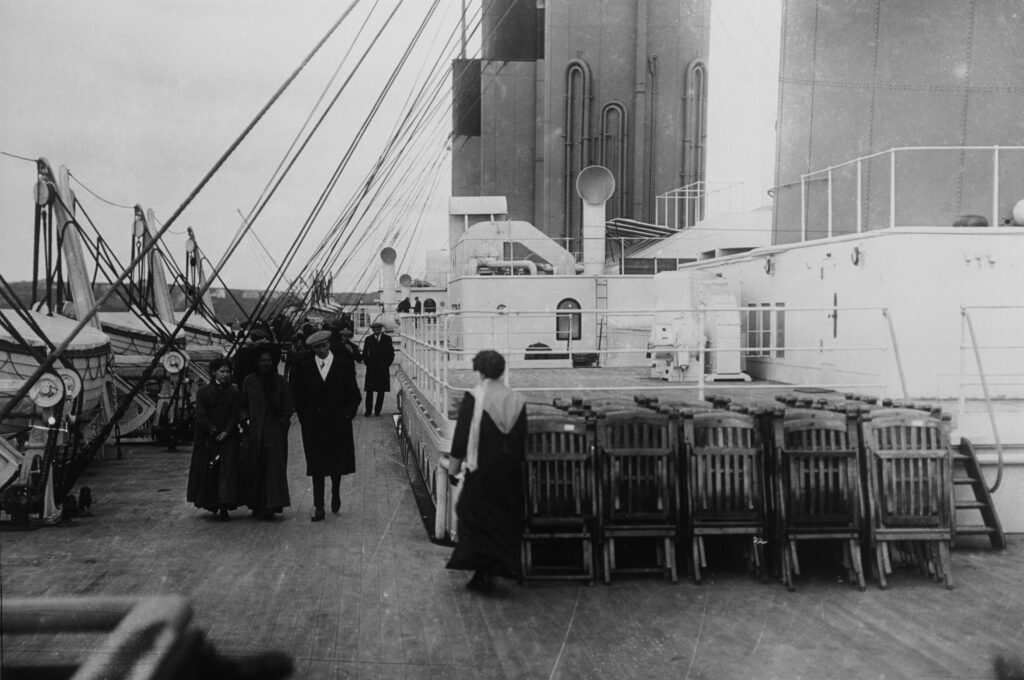
Titanic Tours: Titanic’s Decks Most Titanic enthusiasts and historians dream of the chance to walk the decks of the ship and experience her in all her glory. We imagine ourselves strolling the promenade deck or examining the boats on the boat deck. This week, we’ll explore how those decks were made. A few weeks ago, we looked at Titanic’s frames and how they formed the steel skeleton of the ship, rising vertically to form what we think of as ribs. To these frames and the beams emanating from them, the decks would be attached. It’s important to note that Titanic’s decks were not “flat” by any stretch. They would have had a gentle transverse rise in the center of about three inches. It would have been hardly noticeable to passengers unless they were paying close attention, but it was designed to ensure that water that accumulated due to wave action could easily find it’s way to the sides of the ship and then out the scuppers cut into the hull bulwarks. This rise, called “camber” was present on all of Titanic’s decks. The decks themselves were constructed of steel plates and were assembled along the same lines as the hull, with the in and out system of overlapping edges present. As discussed last week, expansion joints were incorporated into the decks above B deck to allow the rigid steel movement in a seaway. In this way, the decks could flex where needed, but otherwise they were as rigid as the hull itself, while not providing additional strength to the hull girder. The more visible and better-known element of the decks was the wooden sheathing over the steel plates. The wooden planking on her decks was not just decorative, it served a number of important purposes. As steel decks would warm in the sun or chill in the cold, the wood provided a more-uniform temperature for places where passengers and crew would walk regularly. Since wood does not transmit temperature changes, it also helped maintain the temperature inside the ship. Titanic and her sisters incorporated both pitch pine and yellow pine deck planks. The pitch pine was used in high use/high stress areas only, with the yellow pine everywhere else. Planks were typically three inches thick and five inches wide, varying in length to suit the space, and secured to the steel by heavy iron bolts. Once laid, the planks were caulked to help keep them in place. Inside the ship, wood planking was also used in some spaces, but tiles (both linoleum and ceramic), carpet, and parquet could also be found in various spaces. Ceramic tiles were often used in areas where moisture would often be present (lavatories and the swimming pool, for example),while linoleum was found in many passageways, staterooms, and public spaces. Today, tiles from Titanic’s sister Olympic are highly collectible. Next Week: Titanic’s Deckhouses Written By: Nick DeWitt Photo Credit: Titanic Connections Archive Photo Captions: 1: Passengers walk along the boat deck, where pitch pine planks can be clearly seen 2: The well-known (and now highly collectible) two-color tiles found in many parts of the ship are seen here in Olympic’s first class Smoking Room 3: Octagonal tiles are discernable here lining the deck around Olympic’s swimming pool
Design D: The Interior
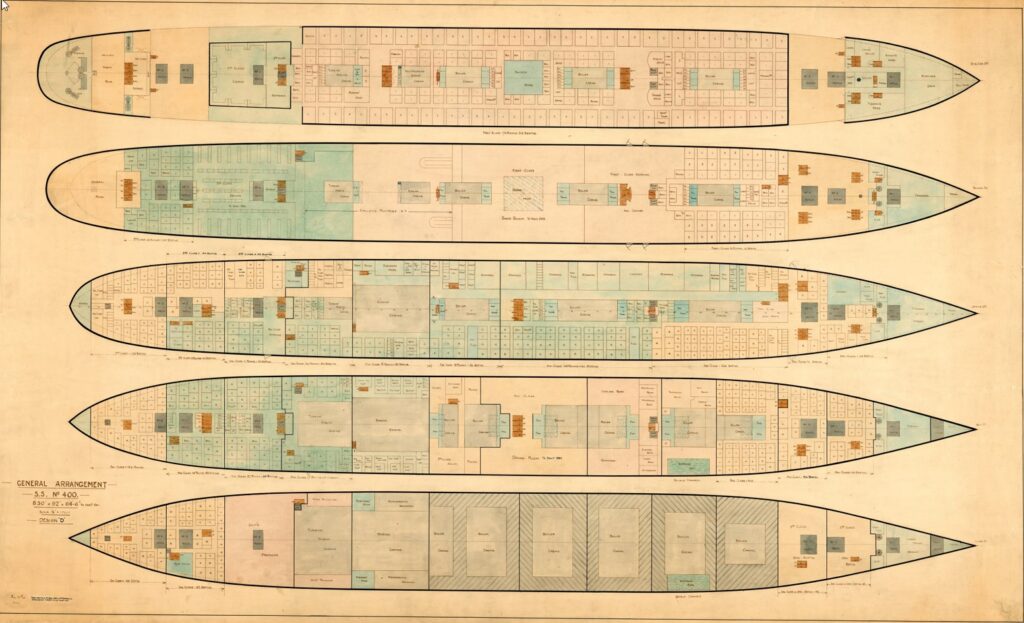
Titanic Design D: The Interior Did You Know… …that the interior arrangements in the original design for the Olympic-class ships, known as Design D, are just as varied from what was actually built as the external features we discussed in last week’s post? While the lack of a second mast after and a clustering of the ship’s lifeboats along the after boat deck is certainly a visual departure from the Olympic-class liners we’ve come to know and love, passengers stepping aboard would have found the ships to be very different from the ones that eventually set sail in 1911 and 1912. The most noticeable change would be the grand staircases. In both cases, these would have been more typical and rectangular staircases, similar to what we eventually saw in the Olympic-class’ second class spaces. The elevators, or lifts, would not have been located behind the forward grant staircase, but across from the front of the staircases, with a port and starboard elevator rather than a stand of three lifts. A deck would be very similar in layout to what was eventually built, with the Lounge, Smoking Room, Palm Court, and Reading and Writing Room all located in the same spots and with the same general shape. The aft part of the deck would have been smaller without the protrusion for the mast and also seems to be lacking the large cargo cranes, although it’s unclear if these are just omitted in the drawings, as no cranes appear around any hatches. B deck is very similar in design to the Olympic, with a large promenade space along the sides, but two major differences jump out from the drawing. The first is the lack of an A La Carte Restaurant for first class passengers. Instead, the second class smoking room is much enlarged. The more interesting change, however, comes near amidships, where there is a large space noted to be for a dome over the first class Dining Saloon. Olympic and her sisters would have a single-deck space for first class to dine, a radical departure from the grand, multi-deck spaces on other large liners built in England, Germany, and France. Design D, at least in this respect, places the Olympic-class ships closer to their contemporaries. This space is also marked on the plans for C deck. In both cases, this unbuilt dome would have taken up space later used for cabins and other small rooms. C deck is otherwise a near-mirror for the as-built ships, with only minor changes to the number and shape of rooms. D deck, however, is radically changed. The first class entrance and a second lounge space, what was later termed the reception room, is much larger in the original plans. Ironically, the final reception room was considered to be a bit too small. The major change here is that the entrances are not walled off from the staircase landing, providing a more open space without altering the rest of the floor plan. Interestingly, the otherwise typical staircase fans out on D deck into a shape more recognizable to our eyes. It is interesting to ponder what Design D’s Dining Saloon would have looked like with a two-deck dome space in its center. The third class General Room is housed here near the stern, as opposed to opposite the Smoking Room for that class on C deck in the final design. E deck holds little more than a few minor alterations, but F deck provides yet another surprise. The Gymnasium, to eventually be found on the starboard side of the Boat Deck, is on the starboard side here instead. The Turkish Bath area is shifted to the port side, where spaces for stewards were eventually located. While this seems a jarring change to us now, this may have been a more practical one in 1912. Olympic and Titanic did not have spaces for changing attached to their Gymnasium. Passengers using the facility would’ve had to pass through public spaces to change, something that would’ve been odd for the times. Most ships that housed a gymnasium at the time had it in the same location as found in Design D. G Deck holds our final major surprises, with the omission of a Squash Court forward being among two notable changes. The other is the location of the ship’s Post Office. Unlike in the final design, where the Post Office was forward on G Deck, Design D places it on the starboard side, but far aft in an area eventually occupied by third class berths. This would certainly have changed some of the story on the night of 14 April 1912, when the mail clerks were among the first to report that their area of the ship was flooding fast. Design D, like most initial designs for any structure, shows a lot of similarities with the what was finally built several years later, but it also shows some interesting differences, some that would’ve advanced beyond typical designs of the time and some which would’ve been a step backward from what eventually became Olympic and Titanic. It is fascinating to look at these designs today and imagine just how different these ships could’ve been. Written By: Nick DeWitt Photo Credit: Titanic Connections Archive Previous Next
Wreck Thursday: An Overview of Titanic’s Stern
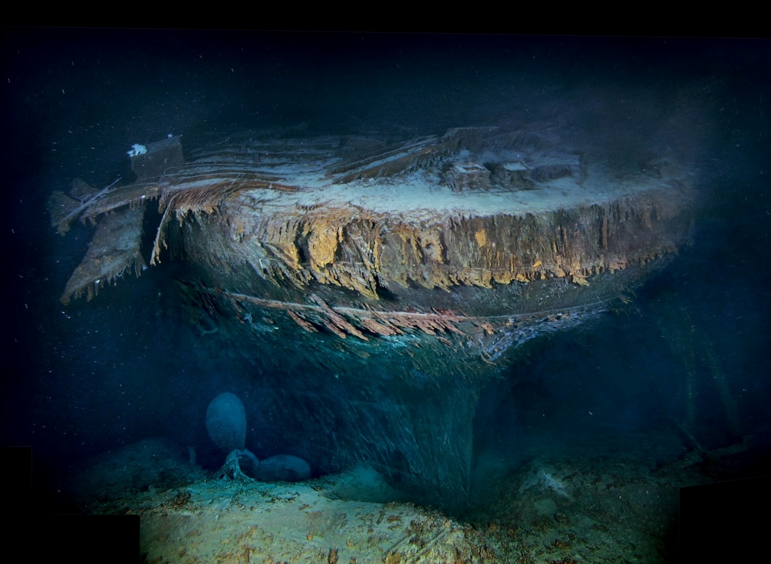
Titanic’s Stern Section: An Overview Located 1,970 feet (590m approx) due South of the Titanic’s bow, lay the mangled remains of the Titanic’s stern section. This area of the ship, the last part of the great vessel to vanish beneath the North Atlantic surface, was a honeycomb of compartments that included crew spaces, 2nd & 3rd class quarters, cargo storage, engineering areas, refrigeration, kitchens, as well as having several large areas for the ventilation of her engineering spaces as well. It is for this exact reason (its design) that the stern section lies so mangled on the seafloor today… These great open areas, many of them containing air pockets, were dramatically, and catastrophically blasted apart by pressure as the great liners sank to the ocean’s depths. The stern section has been covered occasionally in previous Wreck Thursday posts, but it is my hope to ‘Return’ to the Stern in the next series of posts and see if we can’t pick out any details that have otherwise gone unnoticed… Lets begin this ‘Return’ with an overview of the entire Stern Section… Post by: Matthew Smathers Information & Images Courtesy Of:Encyclopedia Titanica,Daniel Klistorner,NOAA,Vasilije Ristovic,Father Browne Collection,Roy Mengot,Titanic: The Ship Magnificent,Bruce Beveridge,Ken Marschall,Mark Draper,Cyril Codus,Woods Hole Oceanographic Institute,Rms Titanic Inc.Storied Treasures Collection,
Did You Know… All About Titanic’s Design “D”
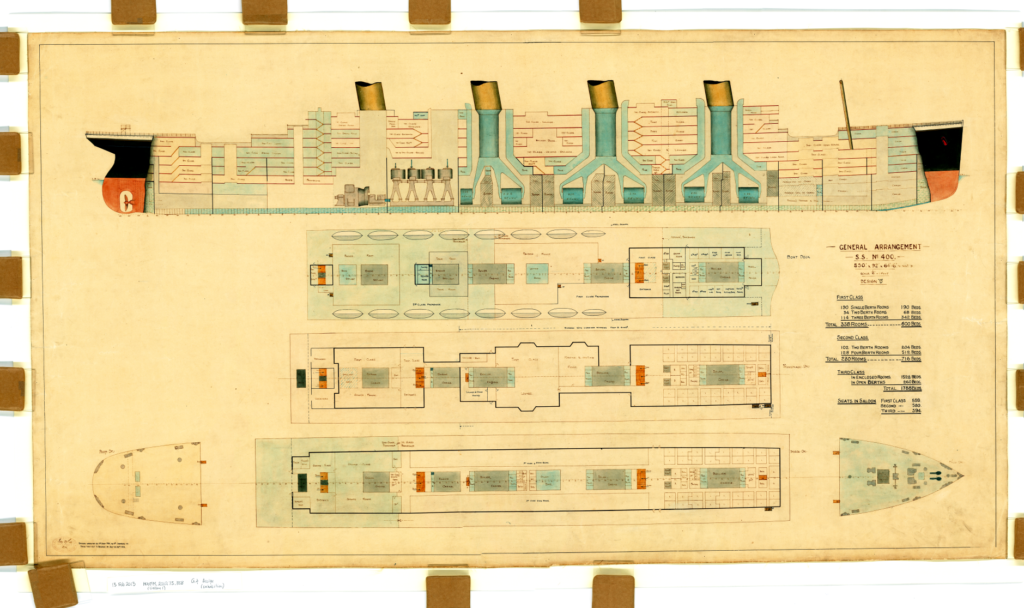
The Intended Exterior of Design “D” For the Olympic Class Did You Know… …that the original design accepted for the Olympic and Titanic, known as “Design D,” had a number of major differences from the two ships that were eventually launched in Belfast? While there are no known drawings of what presumably would be called Designs A, B, and C, we do have the existing Design D drawings, which are the ones upon which Harland and Wolff would have presented to the White Star Line when the two agreed upon the building of the two ships (with the possibility of a third to be completed later). The presumption has always been that the three “missing” designs would be scaled-up versions of the Big Four liners, particularly Adriatic, the last of that grouping. We can only wonder at what the first conceptions of White Star’s new mammoths might have been. Design D, however, shows not so much a scaled-up Adriatic but a design that is in some ways a radical departure from that of ships of the time and in others very reminiscent of other contemporaneous designs. Perhaps that most noticeable thing about Design D, given how important they would later be to Titanic, are the ship’s lifeboats. The design shows 14 full-size lifeboats with two smaller cutters at the front. This, at least, matches the initial compliment on Olympic and Titanic save for the additional four Engelhardt collapsible boats. All 16 boats, however, are placed aft on the boat deck, with the cutters being just abaft the second funnel and each followed by seven evenly-spaced regulation lifeboats. This would have drastically changed the appearance of the new ships. While the placement of the lifeboats would’ve been different to our eyes, it would’ve followed the practices seen in the Big Four. Adriatic’s boats were situated after just as Design D shows them for the Olympic-class ships. A more radical change in the design, however, would be the omission of a mainmast. While not necessarily the first thing noticed in the drawings, a closer inspection shows only the foremast. This would have completely altered several aspects of the Olympic-class ships and been a complete departure from contemporary designs of the time. The new Lusitania and Mauretania each had two masts, while the Big Four ships each had four. A single mast would not become vogue until near the end of the ocean liner era in the 1950s and 1960s. Beyond the visual changes, the Olympic-class ships would have had to make alternative arrangements for their wireless aerial, which could no longer be suspended between two masts. It is likely that, as with some later vessels such as the Empress of Britain in the 1930s, that this aerial could have been suspended between two of the funnels. As wireless was still in its infancy in 1907 and 1908 when these designs were coming together, this was likely not a primary concern to Harland and Wolff, but if followed through on, it could’ve had an important impact on the Titanic during her ill-fated maiden voyage. The rest of the outward design, as far as we can tell, is likely to be very similar to what we have come to know. Four buff, black-topped funnels, the graceful counter stern, the classic bow shape, and even the overall shape of the superstructure are all there very close to the way we remember them. There’s no complete exterior drawing to show exactly what she would’ve looked like, but it’s safe to say that she would’ve looked similar on the outside. The one other exception is the center anchor and hawse pipe, which do not make an appearance on either the overhead drawing of the forecastle or the starboard elevation. The compass platform might also have been located elsewhere, as a dome over the first class lounge appears to be in that spot in Design D. Internally, however, the ships would be quite different. Next time, we’ll take a look at the internal differences between Design D and the Olympic-class as they were built. The first page of the original drawings for Design D, showing a starboard elevation and overhead looks at the Boat Deck, A Deck, and B Deck (including the forecastle and poop) Previous Next
Wreck Thursday: Decks of a Legend
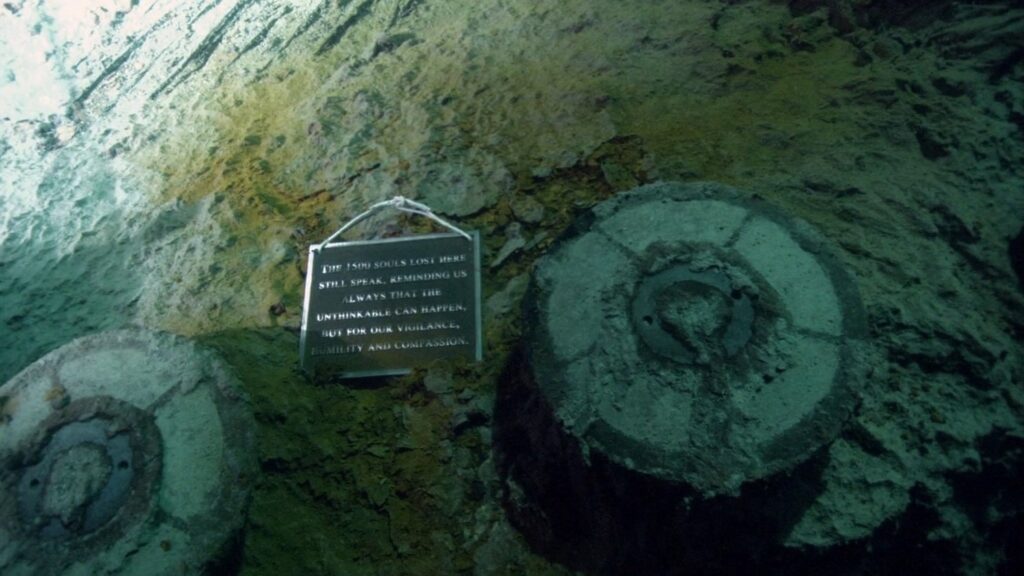
Wreck Thursday: The Decks of a Legend One of the oft-overlooked, (and taken for granted) details concerning the wreck of Titanic has been the lack of visible ‘Wood’ on the great liners’ upper decks. The Olympic Class Liners had decking that was comprised of several types of wood, the primary of which was Yellow Pine, the others being Pitch Pine, and of course Teak. Much like all ships of the period (and even those today), the Titanic’s decks were comprised of steel that was “sheathed” with wooden planking. The decking was not just for aesthetics… it also allowed for a level, safe, surface to walk on, provide insulation, and served to protect the bare steel from corrosion caused by the salty Atlantic air & water. The Titanic’s foredeck & Aft Poop Deck were sheathed primarily with pitch pine (a bit more durable than Yellow Pine) and the ever-resilient teak wood, which was used as trim around much of the liners deck hardware. Both the Boat deck and promenade deck were sheathed with yellow pine and teak, the latter of which trimmed many of the bulkheads and roofs along the officer’s quarters and even the forward Bridge. Teak was the most resistant to decay, and by proxy, it would almost assuredly never have to be replaced unless the equipment it shielded was ever replaced or removed. All of the wood on Titanic was fastened to the steel deck by way of fasteners and dowels. The planks themselves were several inches thick (and varied in size & thickness) and were finally sealed with caulking. When the Titanic was first filmed in 1985 & 1986 a review of the footage started a hasty rumor that the Titanic’s decks were totally decayed, leaving only their bare outlines on the riveted steel. A review of the available footage came to the conclusion that much of what was seen was, in fact, “Ridges of caulking” as opposed to physical wood planks. Thus the rumor began that the great liner was simply a metal shell, devoid of all form of woodwork. This idea prevailed until the 1987 French IFREMER expedition sent cameras deeper inside Titanic than had been attempted by Dr. Robert Ballard and his camera ‘Jason Junior’ (J.J.). Subsequent explorations conducted to the wreck of Titanic have proven these rumors to be false, and as we shall now see… much of Titanic’s deck still remains to be seen and examined. Lets take a look for ourselves…. Please see images for additional text and information. Post by: Matthew Smathers Information & Images Courtesy Of:Encyclopedia Titanica,Daniel Klistorner,NOAA,Vasilije Ristovic,Father Browne Collection,CyArk Archive,Titanic: The Ship Magnificent,Bruce Beveridge,Ken Marschall,Mark Draper,Riley Gardner,Woods Hole Oceanographic Institute,Rms Titanic Inc.Storied Treasures Collection, Previous Next
Titanic Tours: The Framing of the Titanic
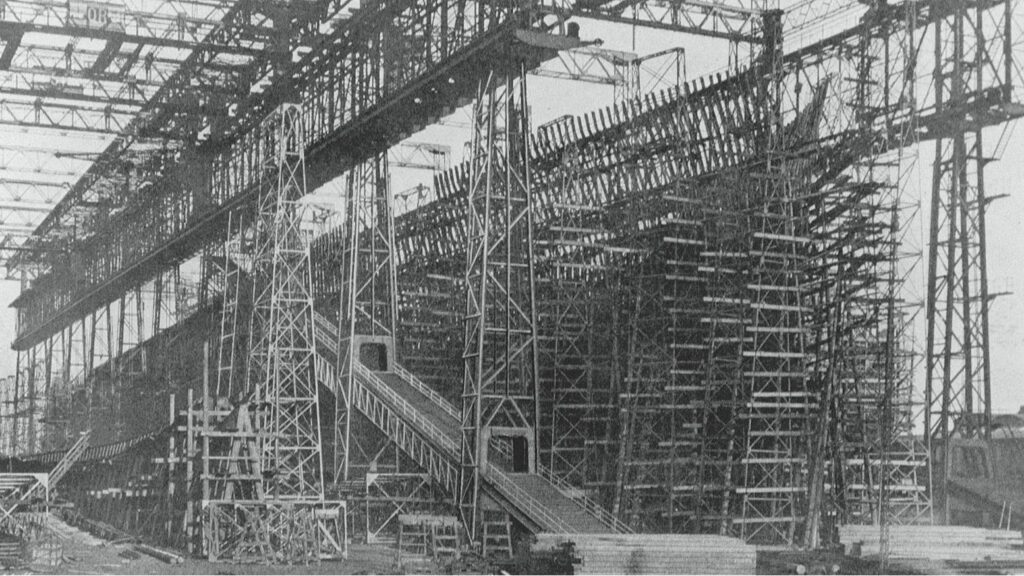
Titanic Tours: The Framing of the Titanic Last week, we looked at the visible outer part of the ship’s hull, her plating, castings, forgings, and rivets. We also discussed the way in which the individual plates were assembled. The plates, which formed Titanic’s outer skin, would not, however, have anything to attach to if not for the frames. The frames inside a ship’s hull are not visible in exterior photographs and are only somewhat evident in photographs of the interior. They are like the skeleton in a human body, giving a ship its overall shape and also providing strength and internal structure. Ships are divided by transverse frames spaced at intervals from the stem to the stern. While various numbering schemes for frames can be used, Titanic’s frames were numbered from amidships, with the exact middle frame left unnumbered. Each frame radiating from that was numbered sequentially and denoted as either forward (“F”) or aft (“A”) of the midship frame. Thus, the frame directly forward of amidships was “1F” and the one directly aft was “1A.” At the forward perpendicular, the forward-most frame was 156F. At the front of the sternpost was the aftmost frame, number 148A. The transverse frames were spaced differently in different areas, closer together at the bow (as close as 24 inches) and stern (as close as 27 inches) and further apart amidships (up to 36 inches). The closer spacing was due to the ship’s experiencing higher stresses on the hull at the ends. The frames ran from the tank top above the cellular double bottom (which formed their floor) to B deck, including the forecastle and poop decks. This formed the “box girder” of the ship’s hull, a hull form that proved incredibly strong and resistant to the high stresses of the North Atlantic routes. Each frame was composed initially of a straight steel bar that was then bent to the needed shape. The frames, once attached to the ship’s bottom, were joined by beams at each deck level. These were supported vertically by pillars and longitudinally by girders. Stringer plates were also fitted in specific areas to increase strength, with these running horizontally along the frames where the vertical distance between beams was larger (as in the holds, boiler rooms, and engine spaces). Stringers were also fitted at B-deck level for added strength. Framing of the ship would be completed before plating, as the plates would attach to the frames. Frames would subsequently be used to identify locations on the ship (you can often see a frame referenced in studies of the damage by the iceberg, for example). With the beams and pillars giving a ship the basics of its internal form, rooms and interior spaces could be constructed around them when the time came. Next Week: Making Titanic Watertight Written By: Nick DeWitt Photo Credit: Titanic Connections Archive Olympic’s framing is nearly complete in this image, showing the skeletal structure which gives the ship her overall form. This looks at her from her starboard bow, with the beginnings of Titanic just visible on the left of the frame. A close-up view of Titanic’s framing in progress
Titanic Tours: The Hull
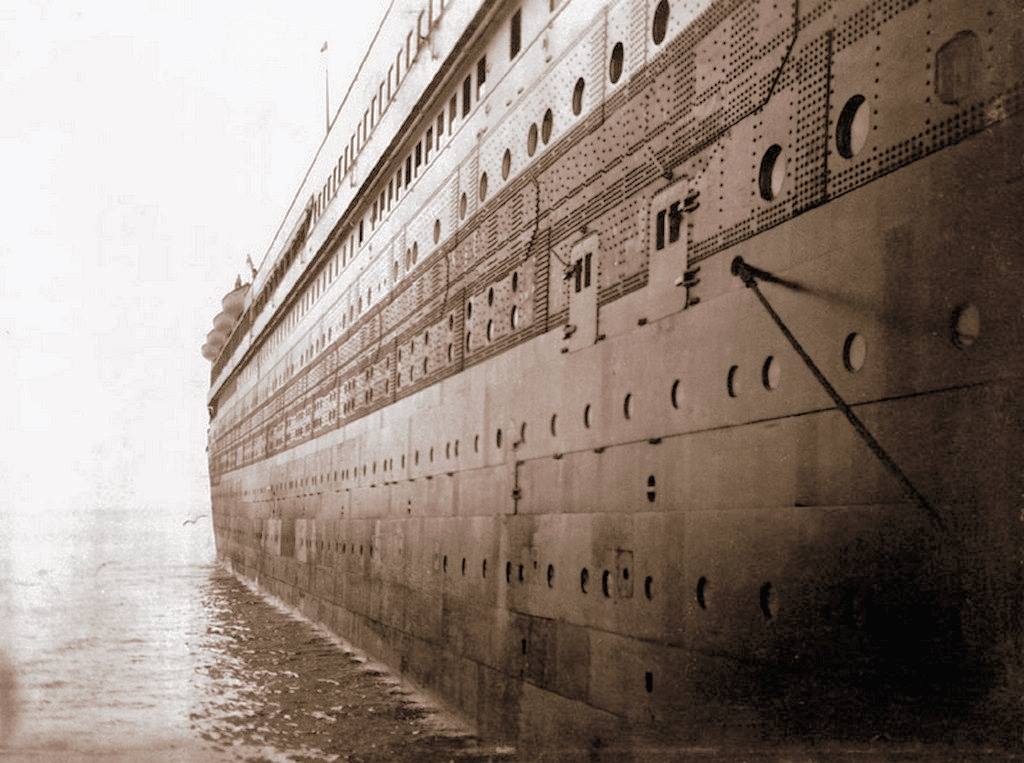
Titanic Tours: The Hull This week, we’ve arrived at something that everyone will be able to recognize right away: Titanic’s steel hull. The construction of her hull is quite intricate, which becomes evident when one closely analyzes photographs of it. From the thousands of rivet heads to the rows of plating defined by their slight overlap, the hull is a study in the shipbuilding techniques of the early 1900s. Let’s start with the basic materials that made up the hull. Titanic’s hull was made up of individual plates, each of them averaging 30 feet in length and six feet in width, with a thickness averaging one inch, but thinning toward the bow and stern ends. The largest plates were 36 feet in length. Each plate weighed in around four tons. The plates were of mild steel, rolled in a low-speed mill, and were of extremely high quality for the time. The plates were held together by rivets, about three million of which were used in her overall construction. Shipbuilder magazine’s special number on Olympic and Titanic notes that over 500,000 of these rivets were located in the double bottom we discussed last week. The rivets were of wrought iron and of various sizes up to one and a quarter inches in diameter. The rivets along the sides of the hull, where the plates were relatively flat and the holes easy to access, were driven hydraulically. The ones at the ends and at the turns in the hull where hydraulic riveting wasn’t possible were driven by hand-hammering. The rivets were placed while still white hot, allowing them to expand into the hole as they cooled. Other parts of the hull, such as the propeller shafts and rudder post, were made by the process of forging, or hammering or pressing a heated steel into a required form. Likewise, the ship’s rudder, stem, and stern frame, among other components, were made by casting, where molten steel was poured into a cast, or pattern. Both casting and forging were used for special shapes that couldn’t be rolled in a mill as the plates were, and also to create parts that were required to be particularly strong and stand up to stress. Two methods were used to assemble the hull, giving its distinct pattern. The lower part of the hull was built with the “clinker” method, where each row, or strake, was placed outboard and overlapping with the previous and lower one. Once the turn of the ship’s bilge was passed and the hull proceeded upward to form the sides of the ship, the method switched to an “in-and-out” one, where an inner strake was positioned against the individual frames and alternated with an outer strake that overlapped the adjacent inner strakes. While much has been made of the strength (or lack thereof) of Titanic’s hull and rivets, it’s important to note that Titanic’s construction used the best methods and materials available at the time. As Harland and Wolff built ships for White Star on a cost-plus basis, there was also no incentive or need to cut corners to meet a budget. Finally, as Titanic sank, her hull was subjected to extraordinary stresses and not only stood up beyond her design specifications and the expectations of her builders, many of her rivets and hull plates remain fully in place today on the ocean floor. The hull was formed around a series of frames. Next week, we’ll take a look at how the framing was completed. Next Week: Titanic’s Frames Written By: Nick DeWitt A close-up of Titanic’s side, showing in great detail both visible riveting (on C and D deck) and the “in-and-out” method of overlapping the plates on the side of the hull The workshop at Harland & Wolff where castings were made. Here, you can see forms for some of the propeller blades, including a workman finishing a blade on the right.
Titanic Tours: the Double Bottom
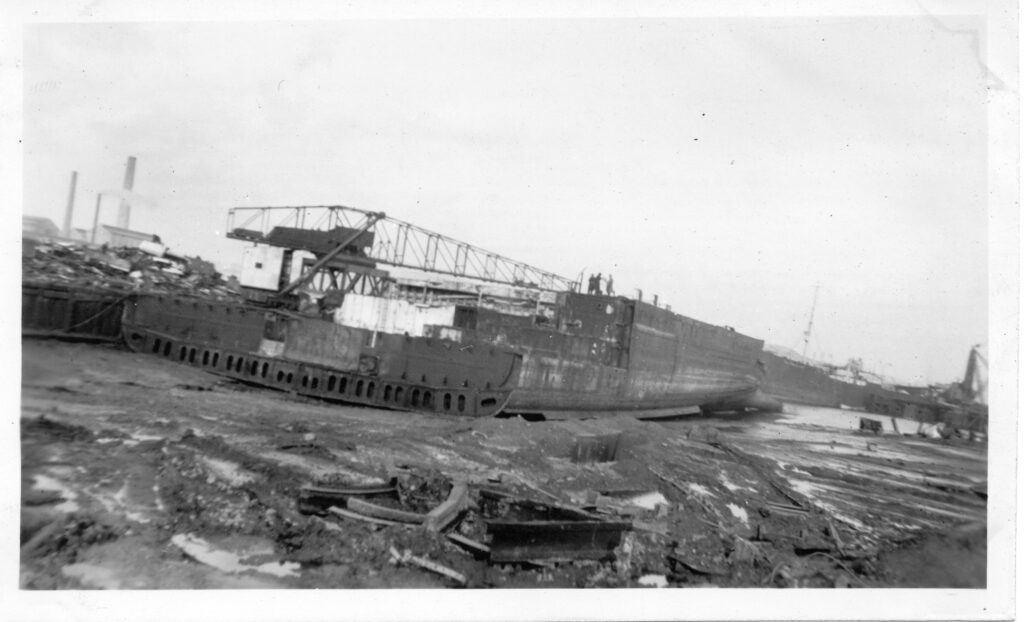
Titanic Tours: the Double Bottom An aerial view of Olympic, looking aft from the bow, showing the subdivision of the double bottom in excellent detail When we discuss Titanic’s watertight subdivision, one of the often-overlooked aspects of her construction is the double bottom. Titanic had what could be called a second or inner skin within the visible exterior hull plates that made up her bottom. As we discussed last week, Titanic had a vertical keel that extended upward from the keel plates themselves. This formed the center point for the double bottom, which took the form of a series of small compartments that formed something of a “honeycomb” at the bottom of the ship under her tank top. Each of these tiny compartments were formed by “floors” at each frame and three longitudinal structures (the keel itself and two margin plates, each located 30’ outboard on either side of the vertical keel). The spaces ranged from 63” to 75” inches in height, being thickest under the heavy reciprocating engines. Each of these “cells” or “tanks” could be utilized for various purposes, from ballast to storage of water. They also were important for Titanic’s stability, preventing water from sloshing around large spaces along the bottom of the ship. Most importantly when it comes to safety features, this cellular bottom and the inner skin it created would help the ship survive grounding collisions where the bottom of the ship was opened to the sea by some obstruction. Rather than a large compartment being opened to the sea and perhaps completely disabling the liner, a small void space would be opened up, giving water much less space to roam free and preventing the ship’s vital components from being damaged or put out of service. As with the keel, Titanic’s double bottom structure can still be viewed today on the two pieces of double bottom that may have formed the final connection between the ship’s bow and stern sections as the liner plunged to the ocean floor. Next Week: Titanic’s Hull Written By: Nick DeWitt Photo Credits: Titanic Connections Archive A view of the Olympic’s double bottom during her scrapping in the mid-1930s from the Titanic Connections Archive
We Remember: The Sinking of the Lusitania
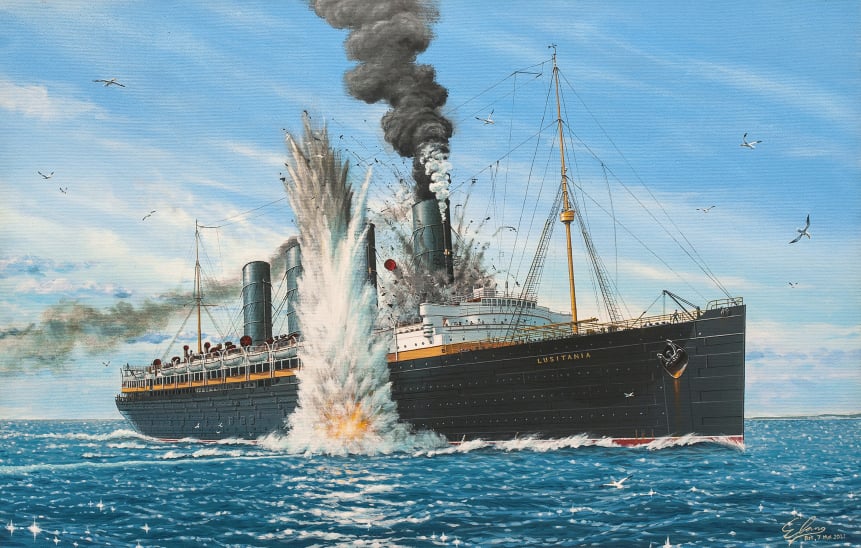
Let’s remember that, on the afternoon of May 7th 1915. Cunard’s RMS Lusitania was torpedoed by U-20 at 2:10pm. One torpedo struck her on her starboard side just aft of the bridge.
Wreck Thursday – Titanic’s First Class Reception Room
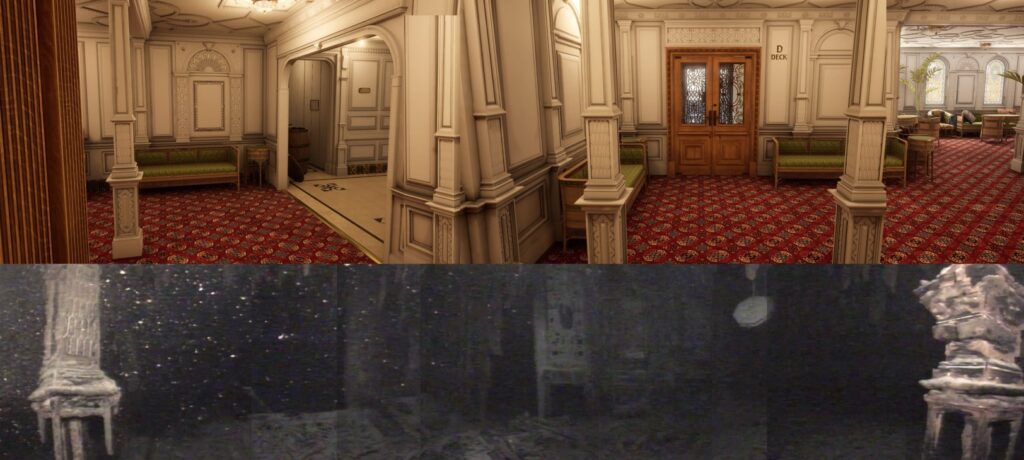
The Titanic’s 1st class reception room was located on D-Deck midships. The first sight for many who boarded the great ship, this opulent room was richly furnished with bright red and ornately designed tile.

